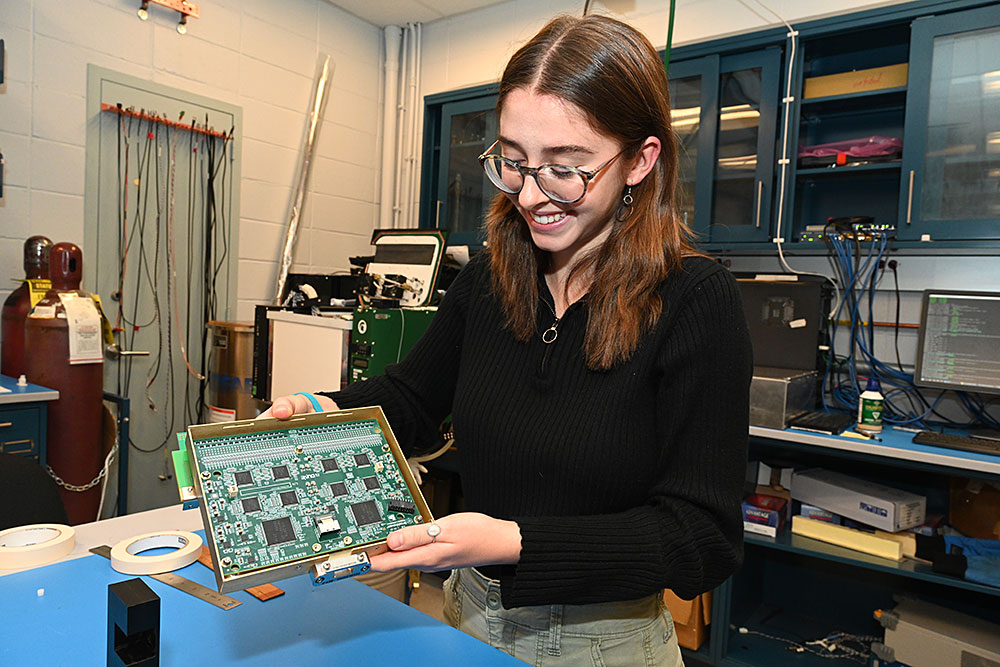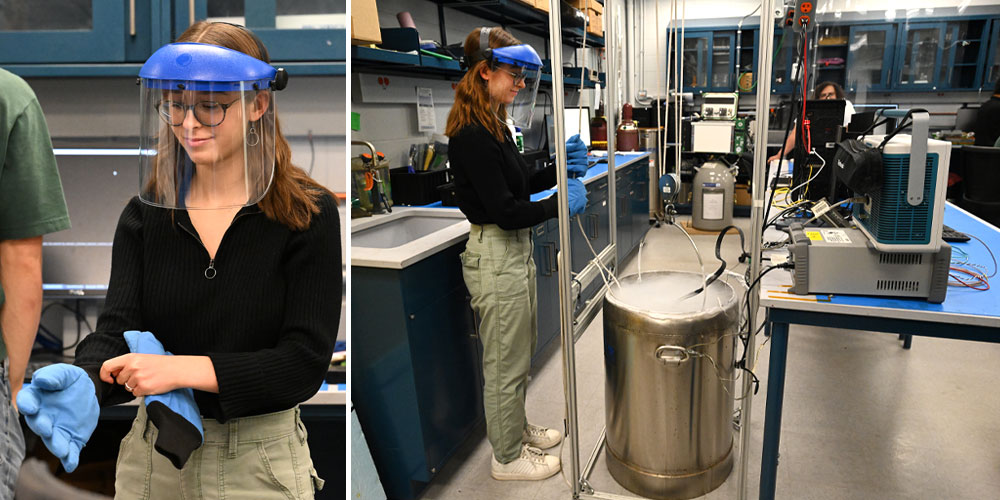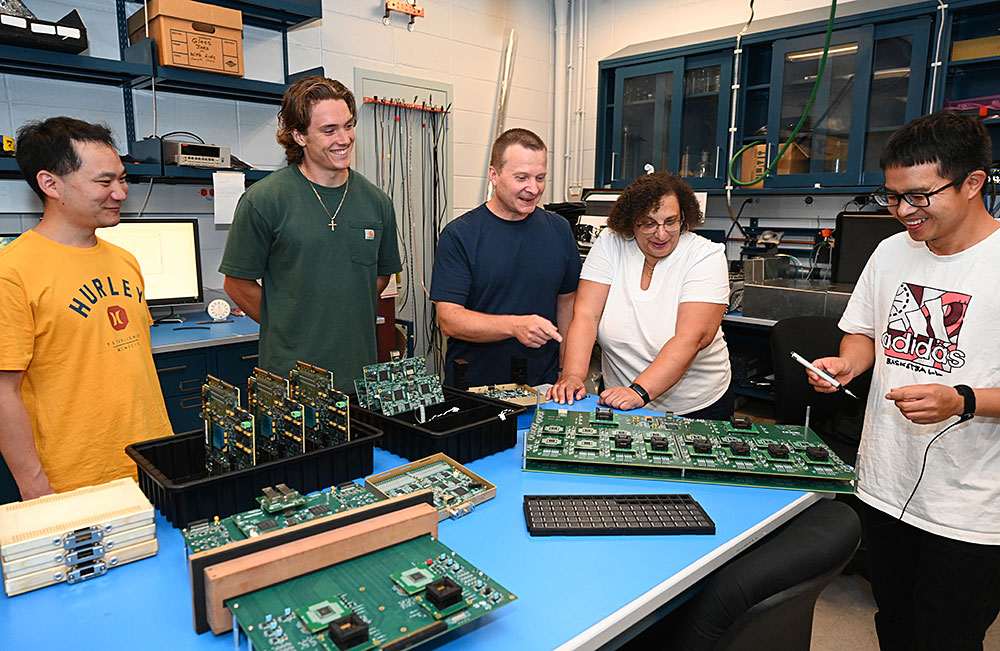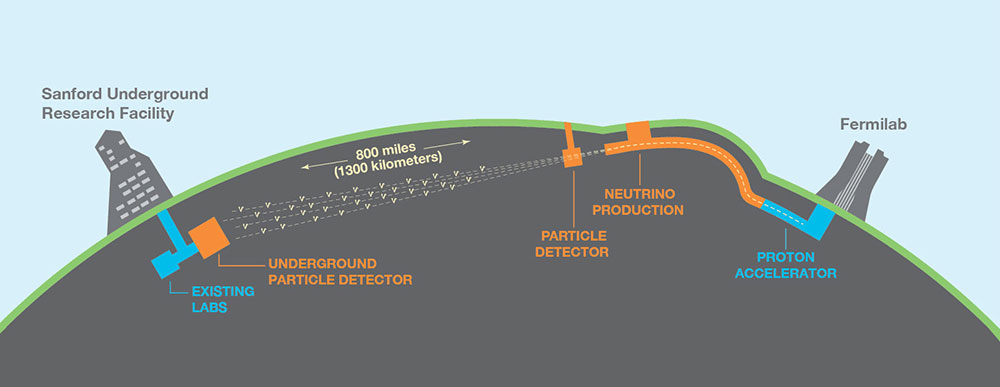The More You Neutrino…
How I spent my summer learning about enigmatic particles that pass right through me by the billions every second!
August 15, 2024
 enlarge
enlarge
Nora Lowe, a summer science writing intern at Brookhaven National Laboratory, holds up a board of microelectronics in the Electronic Detector Group lab in Brookhaven's Physics Department. These electronics were developed for use at frigid temperatures — 87 Kelvin (-303 degrees Fahrenheit) — in detectors for the Deep Underground Neutrino Experiment (DUNE). Lowe wears a grounding band around her wrist to counteract any static electricity that could damage the electronics. (Kevin Coughlin/Brookhaven National Laboratory)
I was astounded to learn that every second of every day, one hundred billion invisible particles pass through my thumbnail. And yours. And everyone’s on Earth.
These ghostlike particles are called neutrinos, rooted in the Italian for neutral and tiny. Indeed, neutrinos are both. Much smaller than positively charged protons and negatively charged electrons, they are nevertheless among the 12 building blocks of matter. Neutrinos are generated in subatomic reactions, including the fusion of hydrogen atoms in stars like our sun. These solar neutrinos travel to Earth, flying through matter at roughly the speed of light — like I picture ghosts might pass through walls in science fiction.
As a summer science writing intern in the Media and Communications Office at the U.S. Department of Energy’s (DOE) Brookhaven National Laboratory, I learned about neutrinos while writing about Mary Bishai, an award-winning neutrino scientist. I attended neutrino lectures by Brookhaven physicists Elizabeth Worcester and Jay Hyun Jo, and I toured a laboratory where “cold microelectronics” designed to detect elusive signals of neutrinos get dipped in liquid nitrogen to ensure they are up to their chilly assignment.
All these experiences confirmed that the best way to learn about something as new and elusive to me as neutrinos is to start at the beginning.
 enlarge
enlarge
Left: After completing cryogenics safety training, Lowe suits up in protective equipment, including a plastic face shield and special gloves. Right: She uses a pulley system to lower microelectronics boards into liquid nitrogen, which is typically between 63 and 77 Kelvin (-346 and -320 degrees Farenheit), for testing. Liquid nitrogen serves as a proxy for conditions the chips will experience at DUNE. (Kevin Coughlin/Brookhaven National Laboratory)
A long time coming
Neutrinos were first hypothesized in 1930 when scientists noticed that beta decay — a process in which an unstable nucleus of an atom gives off a certain kind of energy — was associated with an apparent lack of energy conservation. Purported violation of this fundamental law led scientists to posit that there must be an unknown particle emitted during the decay to account for the missing energy.
In 1956, neutrinos were detected experimentally for the first-time during uranium fission in a nuclear reactor. Nobel Prize-winning research by Brookhaven chemist Ray Davis in the 1960s and 1970s turned up fewer solar neutrinos than expected. This set off a quest for the missing neutrinos. Later experiments cracked the case, showing that neutrinos switch among three states. The neutrinos weren’t missing, merely changing identities.
Flavors, minus the taste
In particle physics lingo, neutrino fluctuation among states is called oscillation, and the states themselves are called flavors. These flavors aren’t tastes, but rather categorical classifications: muon, tau, and electron. A neutrino can exist as any one state and swap identities as it travels some distance through space. The existence of a fourth flavor, called the sterile neutrino, is currently up for debate.
Also not known for sure, I was surprised to hear, is something I thought would be much simpler to measure: a neutrino’s mass. Though the scientists I spoke with are sure neutrinos are very small, they don’t yet have precise mass measurements. So, they often turn to using an analogy: If a neutrino were the size of a grain of sand, an actual grain of sand would be the size of the entire universe!
I had to keep that frame of reference in mind to come to terms with this next part: The fact neutrinos have mass is not currently described by the well-accepted standard model of particle physics — the theory-based understanding of all the known particles and their interactions. Probing neutrino mysteries may give birth to a whole new era in particle physics.
Such vast scientific questions call for an equally grand experimental apparatus, one that the Deep Underground Neutrino Experiment (DUNE) readily delivers.
 enlarge
enlarge
The "cold microelectronics" team looks over boards of chips that will amplify and digitize signals picked up by DUNE's detectors. Fabrication of the boards is a complex, multistage process that combines commercial parts and parts custom-made at the Lab. Chips get sent to an outside plant to be enclosed in a protective structure before returning to Brookhaven for testing and screening to ensure their quality and functionality. The selected chips then go to an outside assembly house to be soldered onto the circuit boards. Finally, the assembled boards return to Brookhaven for more quality control and testing to ensure they meet DUNE requirements before shipping out for installation. Left to right: Lingyun Ke, intern James Rose, Vladimir Tishchenko (who oversees the Electronic Detector Group laboratory), Mary Bishai, and Shanshan Gao. (Kevin Coughlin/Brookhaven National Laboratory)
Production, propagation, detection
There are three stages to DUNE: neutrino production, propagation, and detection.
Researchers at DOE’s Fermi National Accelerator Laboratory (Fermilab) in Batavia, Illinois, will produce DUNE’s neutrinos by accelerating protons. Then, the well-defined neutrino bunches will travel below Earth’s surface all the way from Illinois to Lead, South Dakota. The more than 800-mile (1,300-kilometer) trip, or propagation, in which a neutrino travels through space and time, would take the average person over a day by car. But neutrinos can traverse that subterranean gap in only four thousandths of a second (milliseconds).
It’s important that the experiment be located below Earth’s surface to avoid background signals from other charged particles streaming in from the interactions between cosmic rays and our atmosphere. These “secondary particles” may interfere with neutrino signals picked up by the detectors, so, even though there are some ways to remove their impact on the data after the fact, it helps to be underground to avoid as much cosmic noise as possible.
Upon arrival at the Sanford Underground Research Facility (SURF) built a mile underground in Lead, the neutrinos will enter two enormous detectors. All three physicists I learned from lit up when discussing detection.
DUNE’s neutrino journey will actually be bookended by two sets of detectors — the “far” detectors at SURF and two more “near” to Fermilab where the particles’ journey began. By comparing the mix of neutrino flavors that arrive in Lead with those produced in Batavia, the scientists can learn about the particles’ oscillations along the way.
 enlarge
enlarge
DUNE will send the world's most intense neutrino beam hundreds of miles through Earth's crust from Fermi National Accelerator Laboratory in Batavia, Illinois, to the Sanford Underground Research Facility in Lead, South Dakota. (Fermilab)
Going, going, argon
During DUNE’s first phase, there will be two detector modules at SURF, each with its own cryostat, which can be thought of as a big thermos flask. My jaw dropped when I learned that the cryostats will each hold 17 kilotons of liquid argon at a chilly 87 Kelvin (-303 degrees Fahrenheit) in a roughly 49-foot (15-meter) by 46-foot (14-meter) by 203-foot (62-meter) space — about the size of a commercial airplane’s main body.
Why so big? On top of their miniscule quantity of mass and lack of charge, neutrinos interact via the “weak force” as opposed to the typical electromagnetic and strong forces that dictate more everyday kinds of matter interactions. Therefore, neutrinos interact with other matter very infrequently. Big detectors increase the chances of capturing these rare interactions. In addition, the far detector in South Dakota is bigger than the near one in Illinois because the neutrino beam spreads out as it travels.
Why fill the giant detector with argon? Incoming neutrinos cause argon nuclei to emit charged particles that, in turn, ionize, or give charge to, surrounding argon atoms by knocking electrons free. Similar to how detectives use fingerprints at a crime scene to identify the criminal who left them behind, scientists track patterns that neutrinos make in the detector’s cold argon pool to decipher which flavor of neutrino started the action.
Dimensions and deduction
Because neutrino interactions with argon — and interactions of secondary charged particles with argon — both generate light and ionization charge, these factors can be matched up to derive a snapshot of neutrino flavor. I found this hard to wrap my head around at first, but it helps to think of the task as a puzzle.
The first piece is the light. Because photons travel so fast, photon detectors immediately see the photons from the interaction, providing timestamps for when the interactions took place. These timestamps, in tandem with how electrons released by ionization travel through the argon fluid, render a 3D picture of the neutrino interaction. Two of the dimensions are deduced from the position of the electron charge on the readout plane, while the third dimension comes from measuring how long it took those electrons to arrive after the interaction.
Several thousand circuit boards, made up in turn by tens of thousands of electronic chips, will be picking up and reading out these signals from DUNE’s detectors. These cutting-edge cold microelectronics, specifically developed by Brookhaven to function in frigid argon, are essential for converting signals on the readout planes into digital data that can be analyzed. To ensure readout reliability, the scientists first select functional individual chips by testing them in liquid nitrogen. Then they transfer the chips to an actual circuit board and test that board in liquid nitrogen again. All this pretesting is crucial because once the cryostats are filled with argon, it will be impossible to go in and repair the microelectronics inside.
Out of sight but not mind
DUNE will see its first data in 2029, when I’m 25 years old, and operate for more than two decades.
By that point in my life, my time as a Brookhaven Lab intern will be far behind me. What advances will DUNE have brought about?
For one thing, the experiment is already improving data processing technology to handle the expected massive influx of detector data.
The detectors’ revolutionary cold microelectronics might also help advance other electronics technologies.
The ability to generate powerful proton beams needed to produce DUNE’s neutrinos may find other applications as well. For example, similar proton beams could potentially transform spent fuel from nuclear reactors into materials with lower radioactivity.
But beyond any direct technological applications, what excites me most is how DUNE’s results could inform us about the constructs of life as we know it. The data this experiment yields could one day answer questions about what really happens during supernovae, cosmic events that produce neutrinos but are usually too far away to study in as much detail as we’d like.
DUNE may even chip away at the mysteries of antimatter, which was once believed to be exactly the same as ordinary matter, except for its charge. If neutrinos and antineutrinos behave differently, these particles could demonstrate the violation of a rule that says all particles and antiparticles should act the same under the laws of physics. A violation of this symmetry, in which antimatter behaved unexpectedly, was first recorded in kaons at Brookhaven’s Alternating Gradient Synchrotron, setting the stage for a Nobel Prize-winning discovery. Documenting this rule breaking in the neutrino realm would add to a growing body of evidence that matter and antimatter are asymmetric and have been since the Big Bang.
As I write these words, I imagine the beginning of our universe, when, billions of years ago, there might have been just a little extra matter or, perhaps, matter with some special property that preserved it. Otherwise, matter and antimatter would have annihilated one another, and the universe would be made up of nothing but energy.
So, while we might not be able to see neutrinos, they could hold the key to understanding why there’s anything to see at all.
This article was inspired by information from the 535th Brookhaven Lecture delivered by Elizabeth Worcester, a Physics Department Summer Lecture by Jay Hyun Jo, and a series of conversations with Mary Bishai while writing about her DOE Distinguished Scientist Fellowship.
Brookhaven National Laboratory is supported by the Office of Science of the U.S. Department of Energy. The Office of Science is the single largest supporter of basic research in the physical sciences in the United States and is working to address some of the most pressing challenges of our time. For more information, visit science.energy.gov.
Follow @BrookhavenLab on social media. Find us on Instagram, LinkedIn, X, and Facebook.
2024-22026 | INT/EXT | Newsroom









